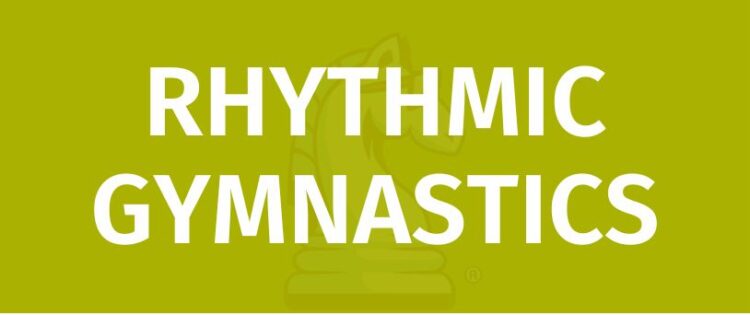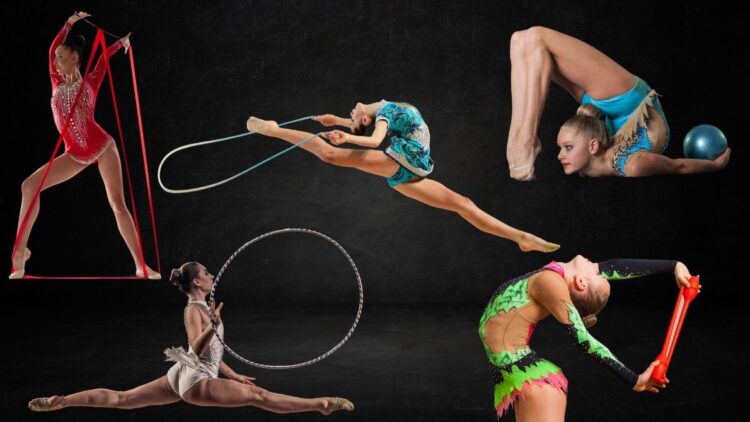
OBJECTIVE OF RHYTHMIC GYMNASTICS: Perform a routine incorporating elements of dance, flexibility, and apparatus manipulation with precision and grace and get more points than the other competitors.
NUMBER OF PLAYERS: 1 or 5 (solo or group)+ players
MATERIALS: Toe shoes, leotard, apparatus
TYPE OF GAME: Sport
AUDIENCE: 5+
OVERVIEW OF RHYTHMIC GYMNASTICS
Rhythmic gymnastics is a gymnastics discipline that focuses more on artistic expression and gracefulness rather than acrobatics. All rhythmic routines are done to music and feature an “apparatus,” or a prop that is used throughout a gymnast’s routine. Rhythmic routines are essentially acrobatic ballet performances, resembling a dance more than a typical gymnastics routine.
Rhythmic gymnastics’ origins can be traced back to the 1700s with the initial work of French ballet master Jean-Georges Noverre. Later, in the 19th century, this concept of expressive “aesthetic gymnastics” took root in Sweden, Germany, and the United States. Essentially, the sport of rhythmic gymnastics slowly evolved across the western world, taking different forms in various countries. What began as a simple expressive ballet routine soon grew into a gymnastics discipline that featured a scoring system that awarded difficulty and execution.
In 1940, rhythmic gymnastics officially became an organized competitive sport in the Soviet Union. In 1961 the International Gymnastics Federation was recognized it. Later, in 1964, the first rhythmic gymnastics world championship was held in Hungary, and Ludmila Savinkova became the first world champion. It wasn’t until 1984, however, that this sport would make its Olympic debut.
SETUP
EQUIPMENT
- Toe Shoes: These sock-like shoes only cover the toes. This minimal covering is designed to allow the gymnast to utilize the grip of the toe shoes while still having the “slip” of their barefoot.
- Leotard: Rhythmic gymnasts wear leotards similar to those of their regular gymnastics counterparts. However, these leotards are designed to be expressive and artistic, often appearing similar to the outfits worn by female figure skaters.
- Apparatus: An apparatus is a gymnast’s prop used during their routine. This apparatus can include a rope, hula hoop, ball, club, or ribbon.
EVENTS

Rhythmic gymnastics includes both a solo and a group event. The solo event features a routine performed by a single gymnast, while the group event showcases a five-person performance.
In solo performances, each gymnast performs four separate routines lasting between 75 and 90 seconds. Each routine features a different apparatus: a ball, clubs, ribbon, rope, or hoop. Every two years, one apparatus is taken out of the rotation, which is why there are five apparatuses but only four routines.
In all-around group events, teams complete two different performances, each lasting between 2:15 and 2:30 in length. The first routine is done with five of the same apparatus, which is often the same for every team. The second routine is often referred to as a 3+2 routine, as each team must use two different apparatuses (three of one, two of another). Similar to the first routine, all teams use the same combination of apparatuses.
GAMEPLAY
Each apparatus is used in slightly different ways:
- Ball: Gymnasts perform bouncing, catching, and throwing movements.
- Hoop: Gymnasts perform large circular movements and roll the hoop around their body.
- Ribbon: Gymnasts use flowing and expressive movements to create beautiful shapes.
- Clubs: Gymnasts perform spins and tosses with accuracy in order to catch both clubs.
- Rope: Gymnasts perform jumps, spins, and rotations while twirling the rope around their body.
JUDGING
Rhythmic gymnastics performances are scored by two panels of judges: one judging the technical difficulty of the routine (signified as a “D” score), and the other panel judging the execution (“E” score) of the routine.
The “D” judging panel consists of four judges who grade the technical difficulty of the routine. This jury’s sole task is to decide how hard a routine is, not how well it was performed. When deciding the difficulty score, these judges look at the body movements of the performer(s), the use of the apparatus, and dance step combinations.
The “E” judging panel is made up of five judges who grade the actual execution of a routine’s elements. This judging criterion includes the artistry of the routine, the synchronization of the dance with the music, bodily movements, and the use of space.
SCORING
For both difficulty and execution categories, judges provide a final score out of 10 points. Each judging panel’s highest and lowest scores are discarded, and the remaining middle scores are averaged together. The average score of each judging category is then added together, resulting in the final score of the performance (with a maximum score of 20 points).
In solo competitions, the score of all four of a competitor’s routines (with each apparatus) is added together. This overall score is then compared to the rest of the competitors and determines who moves on to the next round or wins the competition.
In most cases, rhythmic competitions have two rounds: an initial qualifying round and a final round. In the Olympics, the ten competitors with the highest combined scores from their first four routines move on to the final round. In this championship round, competitors once again perform four routines—each with a different apparatus—to determine their final overall score that is used to decide the competition.
Group events follow the same structure as solo events, albeit with only two routines per team instead of four. Similarly, a team’s two scores are combined to determine if they advance to the final round and then how they rank on the podium. Groups usually consist of five gymnasts each.
For both solo and group events, the score achieved in the first round of competition does not carry over to the final round.
SCORING DEDUCTIONS
Throughout a performance, the execution judge panel will deduct points for mistakes made by the gymnast(s). The number of points taken off a performance’s final score is dependent on the severity of the mistake.
- Minor faults result in a deduction of 0.10 points.
- Moderate faults incur a 0.20-point penalty.
- Major faults can be upwards of a 0.30-point penalty.
- An extreme fault, such as losing an apparatus out of bounds, may incur a 0.70-point deduction.
Judges also deduct points for a performance above or below the required time limit for their Rhythmic Gymnastics Events. For each second above or below this limit (75 to 90 seconds for individual events and 135 to 150 seconds for group events), competitors lose 0.05 points from their final score.
TECHNIQUES

Here are some of the key techniques used in rhythmic gymnastics:
- Leaps and Jumps: Leaps and jumps are essential elements of the sport, requiring strength and flexibility in the legs, as well as good control over the whole body.
- Turns: Turns require balance, control, and coordination, as well as strength in the core and legs.
- Body Waves: Body waves are flowing movements of the body that require flexibility and control. These can be used to create beautiful, fluid routines that help link all of the other elements together. These types of rhythmic sportive gymnastics exercises improve continuous flowing movement and a more firm control over all body movement.
- Other Movements: Rhythmic gymnastics also involves various other movements, such as balances, pivots, and other choreographed sequences.
TRAINING AND CONDITIONING FOR RHYTHMIC GYMNASTS
To become a successful rhythmic gymnast, the athlete must train and condition their body. To train for this sport, which has has many events such as world championships, group competition, and even the Olympic Games, rhythmic gymnasts perform physical demanding tasks and must look flawless while doing so. To achieve this athletes will often focus on four different areas of training: namely, strength, flexibility, apparatus, and cardio. Most athletes do group exercises, and during the group exercise not only improve themselves but also further their teammates
- Strength: Contrary to how they may look, rhythmic gymnasts need to have strong muscles. To build up the strength needed, these gymnasts may perform various exercises, like squats and pull-ups, among others.
- Flexibility: Rhythmic gymnasts also need to be incredibly flexible, especially in their hips, back, and shoulders. Some exercises that help with improving flexibility include splits, bridges, and backbends.
- Apparatus: Athletes practice using their apparatus (hoop, ball, clubs, ribbon, or rope) to improve their coordination, timing, and familiarity with the apparatus. While most rhythmic gymnasts will favor one or two apparatus, they must master all of them.
- Cardio: Rhythmic modern gymnastics routines can be quite demanding, so gymnasts need to have good cardiovascular endurance.
Watching the training needed to master this sport will surely give you a further appreciation for the sheer dedication needed for this beautiful but brutal sport:
TRAINING CAMP IN RUSSIA 2019 / RHYTHMIC GYMNASTICS
END OF GAME
The competitor or team with the highest combined score at the end of the final round of competition is deemed the winner.
- 30 GAMES TO PLAY OVER TEXT - April 22, 2024
- 20+ FREE PRINTABLE BABY SHOWER GAMES - April 16, 2024
- 20+ College Party Games for the Best Night Ever! - April 2, 2024